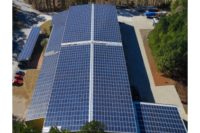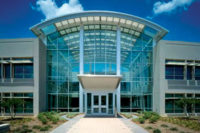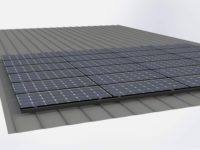Solar Panels and Metal Roofs
Optimizing Metal Roofs with High-Performance Coatings

All photos courtesy of PPG



Solar roofing is not exactly new. In fact, the first commercial solar panel was introduced in 1881. However, the technology did not see mainstream adoption until around 2010. According to the Solar Energy Industries Association, solar roofing panels have seen an average annual growth rate of 25 percent in the last decade alone, representing a significant boom since the turn of the millennium.
As the push for renewable energy solutions gains momentum globally, reliance on solar roofing panels is expected to continue to increase. This has far-reaching implications for the construction industry, which must reconsider how buildings are constructed to support this growth.
Will traditional building methods suffice? What changes need to be made to accommodate solar panel installations on roofs so homeowners and building owners can maximize the return on their investment?
Asphalt or Metal?
Industry research reveals that asphalt shingles account for roughly 75 percent1 of roofing projects in the U.S. today, with metal roofing following behind at around 17 percent2.
Yet despite the dominance of traditional asphalt shingles, solar panels have a synergy with metal roofing that simply does not exist with their asphalt shingled counterparts.
Metals roofs are designed and warranted to last more than 30 years. The same goes for solar panels. Compare that to traditional asphalt shingles on a roof, which traditionally last 15 to 20 years on average.
This represents a construction challenge when installing solar panels on an asphalt roof since the lifespan of the solar panels will often exceed that of the shingles.
This often requires the removal and reinstallation of the solar panels with replacement of the roof, forcing owners to incur not only the costs of a new roofing materials and labor, but also for the reinstallation of the solar panels.
Navigating the Challenges
The primary construction challenge when using asphalt shingles with solar panels is the need to perforate the roof to attach the steel brackets that are used to support the panels. By puncturing the building envelope, it becomes more susceptible to moisture intrusion and potential damage of the substrate and beyond. For that reason, using solar panels on an asphalt roof requires robust sealing methods to prevent leaks and maintain the roof's integrity, which can be a challenge.
Metal roofs offer a more seamless solution.
Metal roofs, especially those with standing seams, allow for the attachment of solar panels without penetrating the roof's surface. This method helps to preserve the roof's integrity and ensure a longer service life compared to asphalt shingles.
In addition, the warranties associated with metal roofs and solar panels are more closely aligned. While asphalt shingles may come with a 30-year warranty, their true service life often falls short. A metal roof, especially those finished with high-performance coatings, can match the longevity of solar panels, ensuring consistent performance over time. The two materials combined offer an integrated system with expected lifespans that more closely match.
Optimizing Metal Roofs with High-Performance Coatings
Coatings from industry-leading organizations like PPG are designed to enhance the lifespan, appearance and long-term performance of metal products even further.
In fact, many solar panel manufacturers protect their products with the same coatings that PPG manufactures for use on metal roofing panels. Therefore, the aesthetics and performance of both materials will remain consistent across the life of the roofing system, offering UV stability and long-term durability. This ensures that both the solar panels and the roof beneath them can withstand harsh environmental conditions without degrading in appearance or function.
PPG supplies large solar panel manufacturers with coatings that have been tested to meet FGIA/AAMA 2605 standards, the highest architectural specifications with strict performance requirements. PPG coatings that meet this specification are 70 percent fluoropolymer resin-based, the very same resin system used on solar panels.
Coatings such as PPG DURANAR® liquid coatings provide excellent weather and corrosion resistance, essential for metal roofs supporting solar panels. These thermal set coatings create a plastic-like protective layer, preventing corrosion and maintaining color integrity of the metal substrate. The coatings are designed to not chalk or color shift, and they offer critical flexibility that accommodates the natural expansion and contraction of metal roofs without cracking or breaking.
The Future of Metal Roofs and Solar
When planning a solar panel installation, choosing a metal roof offers significant advantages in terms of longevity, performance and energy efficiency compared to traditional asphalt shingles. PPG's advanced coating technologies play a pivotal role in ensuring that these benefits are realized, making them the preferred choice for metal roofs supporting solar installations.
It is critical to mount solar panels on a foundation that will last as long as they do. Metal roofs with high-performance coatings are the ideal option with long-term service that is proven. Metal panels are both flexible and modular, allowing for the integration of a portion of solar panels on the roof (with the option to add more later) or expanding to accommodate a home addition.
The push for enhanced sustainability increases in every facet of the construction industry and on a variety of fronts—material selection, decreased carbon footprint, product lifecycle energy savings, and more. As solar panels and metal roofs gain popularity—especially in residential construction—maximizing their potential means relying on the material science behind today’s high-performance coatings.
Looking for a reprint of this article?
From high-res PDFs to custom plaques, order your copy today!







